In 1917, there was a barnstorming team based in Kansas City that was very good – three of its players are in the Hall of Fame. The owner of that team is also in the Hall of Fame. The sponsor of that team is not as well remembered, but I became intrigued when I heard about a baseball jersey.
The trigger for this post came in an email from Hot Stove reader Suzi Schmelzer. She said there was a jersey hanging in the Negro Leagues Baseball Museum that I should see – it is tied to the family of her husband Chip (a/k/a Charles J. Schmelzer, III). I checked it out and you will see the jersey in this photo of the third base side of the Field of Legends (upper left corner, “Schmelzer’S All Nations”). [Grammar note. The capitalization of the second “S” is intentional – that was the company logo style]

Chip and Suzi then invited me to Chip’s office to see other “Schmelzer” sporting goods from a century ago. Chip’s walls and shelves are full of catalogs and old-time equipment for fishing, baseball, golf and many other sports. One of my favorites is a bat with a Schmelzer label and identified as a “COBB MODEL.” Here is Chip with the bat in front of part of the family collection.
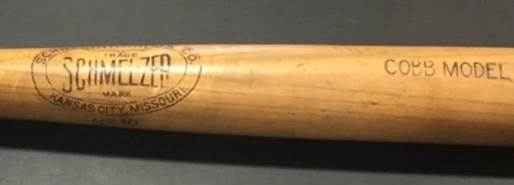
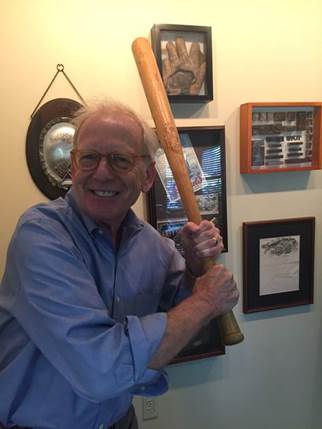
Chip at the Bat
I just had to dig deeper on why the Schmelzer’S jersey had such a prominent place in the NLBM. Google did not disappoint. And I lucked into The Donaldson Network. Led by Pete Gorton of Minneapolis, hundreds of volunteer researchers have combed newspaper files throughout the Midwest to chronicle the career of John Donaldson, a legendary black pitcher who played in Kansas City from the 1910’s to the 1930’s. The Donaldson Network has documented, as of this writing, 401 wins and 5,002 strikeouts by Donaldson. This is needle-in-the-haystack research, and the result is astounding. At your leisure, roam their site: http://johndonaldson.bravehost.com/index.html.
Schmelzer Arms Co.: John F. Schmelzer (Chip’s great-great grandfather) emigrated from Germany in 1844. He was a firearms manufacturer who first worked in this country with the Colt armory in Connecticut. In 1857, he moved to Leavenworth, KS, and started the company that became Schmelzer Arms Co. John’s son Charles F. Schmelzer took over the company when it moved to Kansas City in 1887.
In the early years, the store mostly sold hunting and fishing equipment, but the company grew and expanded its offerings. By the time the company moved to its new “Up-Town” store on 1214-18 Grand, the façade of the building listed fishing tackle, fine arms, talking machines, kodaks, toys, bicycles, cutlery, athletic goods and fireworks. Charles was active in the community and was the 1900-01 President of the Chamber of Commerce.
After more than 70 years, the business ended during the Depression. But not before leaving a special baseball legacy.
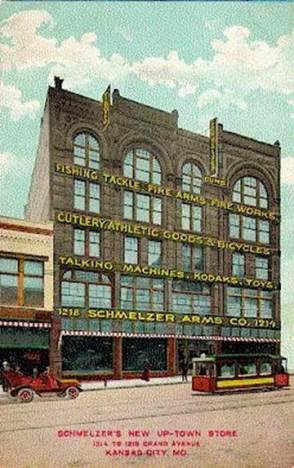
Independent Teams/All Nations: At the beginning of the 20th century, there was no major league baseball west of St. Louis. There was some minor league baseball, but not enough to keep up with the demand. So the gap for fans was often filled by independent teams, semipro teams, town teams, company teams and barnstorming teams. Some were loosely aligned in leagues. Unlike the professional leagues, many of the rosters included black and Latino players.
In the 1910’s, one of the dominant barnstorming teams was “All Nations” – so named to reflect its diverse roster that included several nationalities, blacks and whites, Indians, Hawaiians, Japanese and Latinos. The team was founded in Iowa in 1912 under the management of J. L. Wilkinson and sponsorship of Hopkins Brothers, a sporting goods company. They traveled in style in a private Pullman coach equipped with eating and sleeping facilities (sparing them any Jim Crow issues). Wilkinson moved the team to Kansas City in 1915 and proceeded to build one of the top teams in the country, barnstorming throughout the Midwest with stops in Wyoming, Montana, Colorado, the Dakotas, Nebraska, Oklahoma, Minnesota, Iowa, Kansas, Missouri and probably more.
The best known star of All Nations was John Donaldson, an early version of Satchel Paige, both in pitching skills and as a barnstorming draw. Newspapers quoted Giants manager John McGraw: “If I could change the color of his skin I would give twenty thousand dollars for Donaldson and pennants would come easy.”
Schmelzer’S All Nations: To help advertise its sporting goods business, Schmelzer Arms sponsored teams in many sports, including baseball, soccer and bowling. In early 1915, this included a semipro baseball team that on May 2 faced off against John Donaldson who was making an exhibition appearance for the KC Colts. As sourced by The Donaldson Network: “The Kansas City Colts…administered the first defeat of the season to the Schmelzer’s yesterday, 4 to 0. The features were the fielding of the Colts, the pitching of Donaldson, who struck out nineteen men and let the Schmelzer’s down without a hit, and the homerun of Gray.”
Soon after that no-hit game, Donaldson rejoined All Nations for the regular season. At some point in 1915, Schmelzer Arms became the All Nations team sponsor (the prior sponsors were also sporting goods companies, Hopkins and Goldsmiths). Schmelzer Arms certainly got the desired publicity for the sporting goods sold in its store and through catalogs. For example, from a South Dakota newspaper in July of 1915: “The All Nations team is one of the most celebrated baseball clubs in the U.S. They are sent out as a special attraction by the Schmelzer Arms Co., of Kansas City, MO”. From Sporting Life: the team was “an outfit that baseball sharps claim is strong enough to give any major league club a nip and tuck battle and prove that it is possible for blacks and whites to play on one team.”
John Donaldson, often billed as the “Black Walter Johnson” or “the greatest Colored pitcher in the world,” would wear a Schmelzer’S uniform from 1915 to 1917.
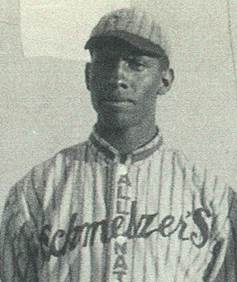
John Donaldson
Broadside ads were often used to announce when the team would be coming to town on the barnstorming circuit (photo courtesy of The Donaldson Network/David Miller). Note the last line: their Pullman private car was named Jeanette.
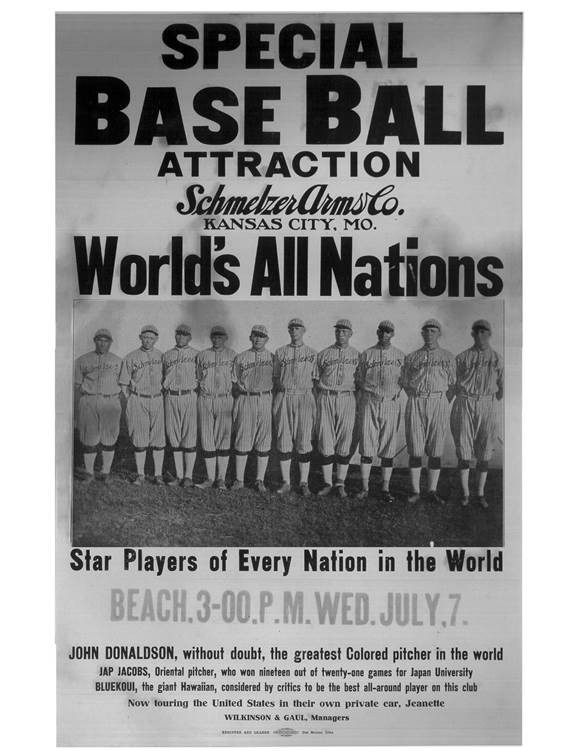
The Donaldson Network has hundreds of entries of games played by Schmelzer’S All Nations from 1915 to 1917. Although the emphasis is on Donaldson, he was not the only star. The diversity suggested by “all nations” was also evident.
Two Cubans were prominent, Jose Mendez and Cristobal Torriente. Mendez was called “El Diamente Negro” (“The Black Diamond”) and John McGraw said he was “sort of Walter Johnson and Grover Cleveland Alexander rolled into one.” Bullet Joe Rogan played some games for All Nations while home on furlough from the famed black army team, the 25th Infantry Wreckers. Goro Mikami was an early (often said to be the first) Japanese professional player. Frank Blattner was sometimes called a “full-blooded Indian” and also played under the pseudonym “Blukoi” as “the Hawaiian.” He was likely neither. African-American Clarence “Pops” Coleman was listed as Italian.
In spite of their great success, the team was forced to disband in 1918 because so many players were drafted for the war. Also, rail traffic regulations for “non-war” use severely limited any use of the team’s Pullman car – a major blow to the logistics of operating a barnstorming integrated team.
The Kansas City Monarchs (née Schmelzer’S): John Donaldson registered for the draft in 1917, listing his occupation as baseball player and his employer as Schmelzer Arms Co. He was not called to war, so he played for various teams in 1918 and 1919. In October of 1919, he was in Kansas City as a member of Rube Foster’s Chicago American Giants. As reported in the Kansas City Star:
“John Donaldson, considered the greatest of all negro pitchers, will work for the Giants, and Dixon will be his battery mate. ‘Rube’ Foster, manager of the Giants, has been investigating the baseball situation here this week and has intimated that a negro league will be organized during the winter months. Kansas City may land a team in the organization.”
Just four months later in February of 1920, Rube Foster would indeed form his new league in a storied meeting at the Paseo YMCA in Kansas City. Eight teams became members of the Negro National League, and J. L. Wilkinson (the only white owner) was awarded the Kansas City franchise.
Wilkinson stocked his team with several players from his Schmelzer’S 1917 roster, including John Donaldson, Jose Mendez, Frank Blattner, Hurley McNair and Bullet Joe Rogan. Several of Rogan’s teammates from the 25th Infantry Wreckers were also signed by the team (some on the recommendation of Wilkinson friend Casey Stengel). The potential name for the team was the “Browns,”, but John Donaldson suggested that it be called the “Monarchs,” a name for an earlier Kansas City team.
So the Schmelzer’S All Nations team, with an assist from the 25th Infantry, became the Kansas City Monarchs.
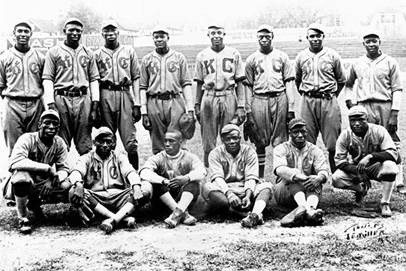
1920 Monarchs (courtesy of NoirTech Research)
Wilkinson also brought back All Nations in 1920 and kept the team barnstorming for several years. The team served as feeder of players for the Monarchs, but the main benefit was to capitalize on the lucrative barnstorming routes paved by his Schmelzer teams. To help draw crowds, members of the Monarchs would make spot appearances, especially John Donaldson who continued as a headliner. In 1922 and 1923, Donaldson played most of his games for All Nations. Wilkinson needed the barnstorming money as his Monarchs struggled financially in the early years. Donaldson was also paid well, but his long-term legacy was somewhat dimmed because he did not play many games in the “major leagues” – black or white.
I have not found any evidence of Schmelzer’S sponsoring the All Nations teams of the 1920’s. The company did stay connected to the Monarchs as a supplier of equipment and uniforms. As a precursor of Nike, they touted this in their advertising. From the Kansas City Call, April 27, 1928:
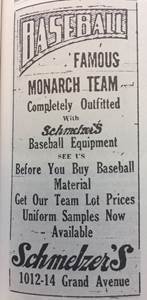
As the Depression rolled in, Schmelzer Arms went out of business. So did the Negro National League, playing its last season in 1931. Wilkinson returned to his roots and put the Monarchs on the barnstorming trail he had taken with Schmelzer’S. The team was immensely popular. The Monarchs joined the new Negro American League in 1937 and enjoyed success at the gate and on the field. They barnstormed to supplement their league play, and Satchel Paige and others played in the post-season against white all-stars teams led by the likes of Dizzy Dean and Bob Feller. Starting with Jackie Robinson, Monarchs players were the first to integrate 7 of the then 16 teams in the majors. The Monarchs were baseball royalty, just as suggested by their team name.
John Donaldson continued to be a big draw throughout the 30’s, playing for many teams. Some of his longer stays were in Minnesota, and this is how Minnesota resident Pete Gorton learned about him and started The Donaldson Network. In 1949, Donaldson was hired by the White Sox to be the first full-time black scout in the majors. He reportedly quit when the Sox declined to pursue Ernie Banks. Banks was starring in KC for the Monarchs, and the Chicago Cubs wisely hired Buck O’Neil as a scout to pursue Banks for them. And Ernie became Mr. Cub.
Schmelzer’S in the Hall of Fame: Many of the Schmelzer’S players went on to have outstanding careers in the Negro Leagues. Three players from the 1917 Schmelzer’S are in the Baseball Hall of Fame: Jose Mendez, Cristobal Torriente and Bullet Joe Rogan. As is team owner J. L. Wilkinson. The missing link is John Donaldson who should be in the Hall. With the work done by Pete Gorton and his band of researchers, I’m betting that Donaldson gets strong consideration in a future vote. The work of The Donaldson Network was rewarded this past May with Donaldson being inducted posthumously into the Missouri Sports Hall of Fame (he was born in Glasgow, MO).
Another 1917 team member, Bill “Plunk” Drake, went on to play for several Negro League teams. As told by Buck O’Neil, Drake “taught Satchel how to throw the ‘hesitation pitch,’ where Satchel would kick up his front leg so high it eclipsed the sun, hold it for a split second, and just when the batter was wondering when he was going to throw the ball, throw it. That would have batters all tied up in knots trying to hold back on their swing.”
The Donaldson Network and the NLBM: I had the good fortune to meet Pete Gorton earlier this year at the Negro Leagues Baseball Museum. He was in town to announce that the archives of The Donaldson Network will be donated to the museum for its future Buck O’Neil Education and Research Center. The Center will be housed in the Paseo YMCA where the Negro National League and the Kansas City Monarchs were founded in 1920.
Pinbacks: Schmelzer’S issued advertising “pinbacks” (circa 1912), and they are revered today by collectors for their rarity and design. The set includes a manager and nine players (including Shoeless Joe Jackson plus Hall of Famers Ty Cobb, Christy Mathewson, Johnny Evers and Rabbit Maranville):
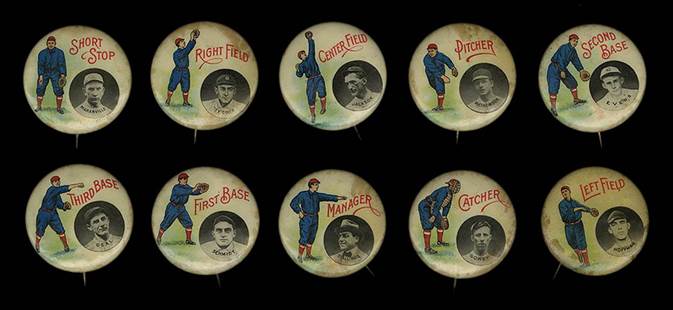
The reverse side of a pinback:
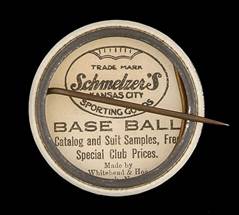
In 2006, a collection of 12 of the pinbacks (including 3 of Cobb and 2 of Jackson) were sold at auction for $81,200.
Chappell’s: I knew of one other local place that might have a Schmelzer’S jersey. Chappell’s Restaurant and Sports Museum in North Kansas City. Jim Chappell no doubt has the most comprehensive sports memorabilia collection in the area. And sure enough, he has the jersey. It is just like the one at the NLBM – a vintage reproduction from Ebbets Field Flannels. I doubt any originals still exist. Coincidentally, Jim’s mother worked at Schmelzer Arms Co. for several years. Here is Jim with his Schmelzer’S jersey, standing next to some of his Monarchs memorabilia:
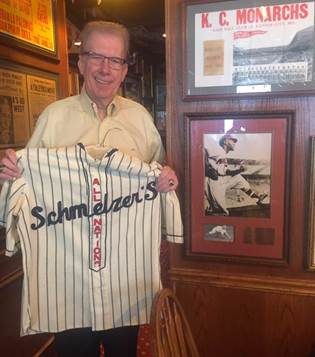
Hemingway to Alexander to Schmelzer’S: On October 14, 1917, the Kansas City Sun reported that Schmelzer’S All Nations would be in Kansas City for a double header, noting that “John Donaldson will pitch.” Four days later, an 18-year-old cub reporter joined the Kansas City Star. Ernest Hemingway. I would not have noted this timing if I had not seen a post by Steve Paul about his new book. Steve is a former writer and editor at the Kansas City Star, and his book on the young Hemingway will be released on October 1. He is doing an author event at the Plaza Library on October 3.
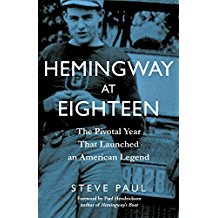
Hemingway was not covering sports for the Star, but Steve sent me a copy of the one baseball article written by Hemingway. It was in the paper on March 13, 1918, under the headline ‘ALEC’ LEFT WITH THE CUBS. “Alec” was Grover Cleveland Alexander, one of the best pitchers of all time. He was in Kansas City to board a special train car carrying members of the Chicago Cubs to spring training in California. He was still holding out for a $10,000 bonus, and Hemingway pondered if fans would eventually hear that Alec “has ornamented a contract with his own peculiar style of hieroglyphics.” Soon after that, both Alexander and Hemingway headed to Europe for the war (each receiving serious injuries).
Fast forward to 1926. A big year for each of them. Hemingway published his first full-length novel, The Sun Also Rises. Alexander pitched for the Cardinals in the World Series against the Yankees. Alexander won Games 2 and 6 and came on in relief in the 7th inning of Game 7. The Cards led 3-2 into the ninth, and Alexander got the first two outs. He then walked Babe Ruth. Next up would be two good hitters, Bob Meusel and Lou Gehrig. In a bizarre ending to the Series, Ruth tried to steal second and was thrown out with Rogers Hornsby applying the tag.
The team pictures from that 1926 Series were used by Schmelzer’S to promote a genuine oil tanned horsehide glove:
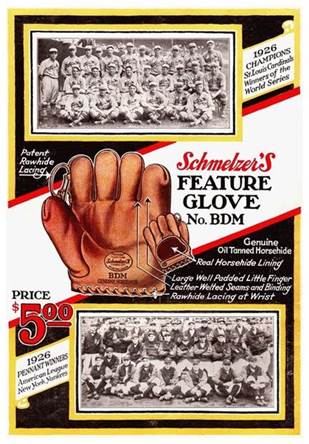
Now a Yogiism to end this post. Toots Shor’s Restaurant drew many celebrities in NY in the 40’s and 50’s. One was Ernest Hemingway who by then was a famous author. Some Yankee players were also regulars. One night, Yogi Berra was introduced to the “great writer” Ernest Hemingway. Yogi asked “Yeah, what paper you write for, Ernie?”